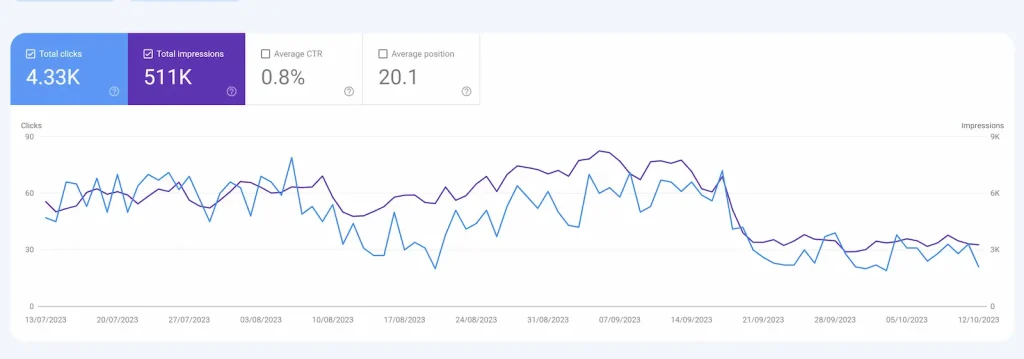Key Takeaways
- Choose the right Content Management System
- Update your content and increase visibility on Google
- Increase speed and improve user experience
If you’re here, you’re likely in the midst of, or at the very least considering redesigning your website.
Maybe your website looks obsolete, and you believe it’s time for a change, or you want to rebuild the user experience to address a problem with sluggish traffic and declining conversions.
But not only these are the reasons; continue reading and discover the main reasons you should redesign your website.
Redesign a website, What is this?
7 Reasons Why You Redesign Your Website
Rebuilding your current website largely depends on the marketing objectives you consider applying to your business. The scope of your website makeover will depend on your business goals.
If your branding has changed, your site may require a minor change; however, if your marketing plan has been fully redesigned.
You may need to switch to a content management system with the flexibility and customization options necessary to remodel your site.
If you have no idea when you should consider doing this in your business, learn the most common reasons why companies need a website redesign:

1. Outdated Content & Code
If your website has broken links, such as 404 error pages, it may be an indication that it is disorganized and not well maintained.
Consider a website redesign project for your site if it has numerous broken links, mistakes, missing graphics, and other problematic components.
Additionally, the abundance of script libraries, pictures, and designs on outdated websites typically causes them to load slowly. The performance will be hampered by websites that employ non-optimized, uncompressed scripts.
Loading your stunning graphic or scrolling banner shouldn’t keep users waiting. So, users are then more likely to visit a competitor’s website.
2. Increase Visibility on Search Engines
New and fresh information is considered by search engines like Google, Yahoo! Bing, Yandex, and others when determining rankings, so you need to pay attention to this item.
In this sense, constant technological modification and content updates are necessary to rank well on a search engine results page.
Activities like selecting keywords and optimizing pages for relevant keywords are examples of technical elements. Certain CMS platforms make it simple to set information independently without having to modify the code.
If you don’t have a content management system, you probably need some assistance from qualified web developers.
A website redesign is necessary if your website is not being noticed. You should regularly update new content on your website if you want to be seen more prominently in search results.
As a result, it is crucial to work on the content of your own website and
3. Increase Speed
If the pages of your website load very slowly, the chances are very high that visitors will leave the site quickly. Your web pages must load swiftly and effortlessly to lower bounce rates and boost visitor engagement.

Speed-optimized websites improve the user experience and potentially improve your search engine rankings.
4. Improve User Experience
Your website must be user-friendly. Visitors ought to be able to find the information they’re looking for within just a few clicks.
If they can’t, it might be time to look at your site’s organization and the routes users must take to get crucial information.
The user experience will only be improved by straightforward navigation and organizing, boosting the likelihood that they’ll stay on your site and visit again.
5. Mobile Friendly
New screen sizes come with new phones, which can be a big problem. Your website may occasionally appear and perform poorly on these new devices due to this.
Your website’s search engine ranking will probably suffer if it is not mobile-friendly. Modern websites are becoming more user-friendly and responsive.

The objective is to make your website behave and interact consistently across platforms. As a result, user behaviour and search engine optimization will increase (SEO).
Font sizes are the first step in making a website mobile-friendly. Mobile devices should be able to read everything, including photos and social media feeds. Users must be able to quickly and readily retrieve the needed information. Thus, the material must be clear and succinct.
6. Beat Competitors
Maybe your competitors are stealing your customers with their flashy new websites.
This really can happen. When this happens, and you can recognize that a competitor’s website is more attractive than yours, it’s time to change your website.
You should make your site more current, easier to use, practical, etc. A company’s website impacts purchase decisions of the order by 70%, so it is important to work on improving your site and not let the competition steal your customers.
7. Social Integration
You don’t have social media integration on your existing website, and you need this urgently.
Social media can help you increase brand awareness and reach among other important objectives. In addition, they make the interaction on your website more extensive and, at the same time, help you increase followers.
Ready to start your website redesign?
If some of the 7 reasons mentioned previously are all too similar to you, your website is probably out of date. Perhaps you don’t need to start from scratch and create a new website.
However, it’s crucial to fix the mistakes and keep your website performing at its best.
Your website is there to help you market your company, establish your brand, and boost sales.
It isn’t serving its intended purpose if you aren’t obtaining the desired outcomes despite your website being stunning, useful, and pixel-perfect.
So, consider redesigning your website if you are dissatisfied.
source https://webjuice.ie/7-top-reasons-why-you-redesign-your-website/

No comments:
Post a Comment